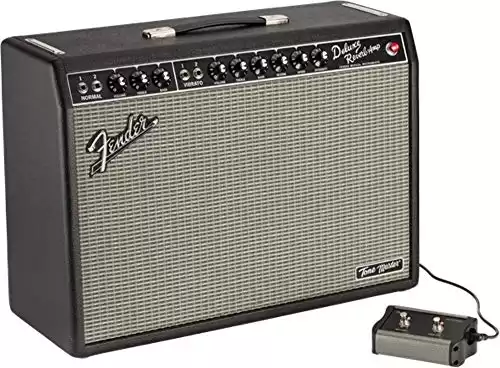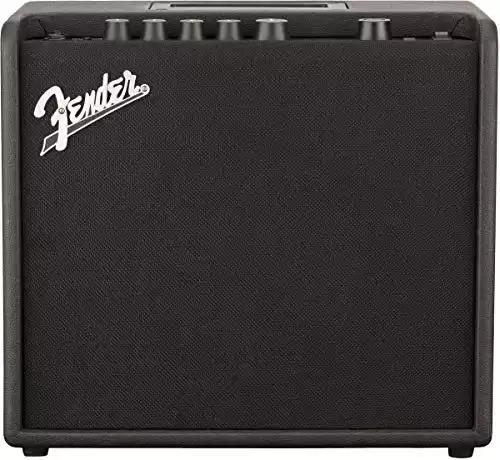Fender introduced the Princeton series of amps for guitarists in 1947. The original line was discontinued in 1979, but the company created a few variations in the 1980s and 1990s to continue providing affordable support to players worldwide.
The solid-state Fender Princeton Chorus amp first reached the market in 1988. This design is notable because it operates 25.5-watt amplifiers in stereo mode.
If you have a Fender Princeton Chorus amp with a red knob, that means it was made in the United States from 1988 to 1991.
Should your amp have a black knob, that means it was manufactured in Fender’s Mexico facilities from 1991 to 1997.
In 2006, the Princeton series returned for a pro-tube model and an amp in the Dyna-touch II series. This review is for the products that Fender made from 1988 to 1997.
The current retail value of a Fender Princeton Chorus amp depends on its condition, but most sellers offer them for about $200 today.
Is Fender Princeton Chorus a Good Amp?
What makes the Fender Princeton Chorus stand out as an amp series is its solid-state design with plenty of power. The rounded speakers work with the brand’s two standard input options, mono and stereo FX loop, and other features to deliver enough customization for the average player.
When you have the Fender Princeton Chorus amp available to use, the ten-inch speakers offer some excellent low-end sounds without compromising what is possible in the mid-range.
It records nicely, even with internal microphones on devices like the iMac, ensuring that you get the chunky distortion you want while maintaining clean tones.
If you look at the Fender Princeton Chorus amp’s settings profile, you’ll get chorus setting options that include rate and depth control.
When you’re on the clean channel, you can use bass, mid, treble, volume, and reverb controls, while the distorted one offers a limiter, gain, volume, and presence.
You’ll also have a mid-boost switch that allows any player to tweak their settings so that their guitar sounds like a million bucks.
Although the chorus features are factory-installed and about average, you’ll get lots of reverb out of this amp.
After playing with it a few times, I’d highly recommend sticking with the clean channel for most general playing purposes.
If you need planned distortion for a composition, I’d recommend using a multi-effects board with the Fender Princeton Chorus amp. At the very least, route it through an external distortion pedal.
With that said, you won’t find many better series-style options with over 30 years of experience in the marketplace like what Fender offers with the Princeton Chorus. It puts some punch into your playing style.
What Sounds Are Possible with the Fender Princeton Chorus?
You can play virtually any guitar with the Fender Princeton Chorus amp. It always delivers an authentic result that doesn’t feel elitist, low-fi, or designed to be a beginner’s product.
Although it shines more in the mid-range overall, what I love about the amp is the growl and punch it delivers in the lower frequencies.
If your playing style keeps you on the higher end where listeners want an above-average tweeter to hear your work, the Fender Princeton Chorus amp might not give you the crisp notes you want.
The frequency response up to 6 kHz is excellent, but it drops off a cliff afterward.
You can always fix the issue on the higher frequencies with a pre-amp or an effects processor, although you lose a little of the original Fender sound from that effort.
I’ve also found that the cabling style matters a lot when working with this amp. That’s why I prefer the GLS Audio instrument cable.
It uses a 1/4-inch TS to a 1/4-inch straight setup, covered in a brown-yellow tweed cloth jacket.
It has more flexibility than other cords, a low capacitance, and excellent sound transmission qualities.
Since it is only 38 Picofarads per foot, you’ll get an above-average result without needing to pay hundreds of dollars to get that number under 30.
If you don’t need 20 feet of cable for your Fender Princeton Chorus amp, you’ll get an even better result!
Having that right angle on the one side is a lifesaver as a guitarist. It prevents you from damaging the plug or the jack, reduces the risk of an impact incident, and doesn’t interfere with your playing style.
Even the color helps you see the cable better when you’re on the stage! The insulation work is above what you’d expect at this price point, while the soldering and general construction hits on every note you want.
■ What Are the Specs of the Fender Princeton Chorus Amplifier?
Here is all of the vital information you’ll want to review about the Fender Princeton Chorus amp’s manufacturing and design. It is listed as part number 22-5700.
| Dimensions: | Height: 17.5 inches (44 cm); Width: 22-3/8 inches (57 cm); Depth: 10-3/16 inches (26 cm) |
| Weight: | 38 pounds (17.2 kg) |
| Input Impedance: | Input 1: 1 meg Ohm; Input 2: 131k Ohm |
| Nominal Level: | Input 1: 100mv; Input 2: 200mv |
| Power Output: | 25.5 watts RMS per channel for a total of 51 watts |
| Rated Load Impedance: | 8 ohms per channel |
| Mono Effects Loop: | Nominal Level: -10 dB; Send Output Impedance: 1k Ohm; Return Input Impedance: 25k Ohm |
| Power Requirements: | 120v AC 60 Hz; 145 watts maximum; 1.2 amps maximum |
| Stereo Effects Loop: | Nominal Level: -10 dB; Send Output Impedance: 1k Ohm; Return Input Impedance: 150k Ohm |
| Speaker Complement: | Two 10-inch speakers using Fender’s 8 Ohm specialty design. |
As it says in the original owner’s manual, you’ve got two options for sound when managing the Fender Princeton Chorus amp at home. It can be “TUBE or not TUBE.”
It’s a little funnier if you think about it in terms from Shakespearean language: “to be or not to be.”
■ Can I Play the Bass on the Fender Princeton Chorus Amp?
Although the Fender Princeton Chorus delivers a well-rounded sound, it’s not especially suited for the bass guitar.
This amp thrives in the mid-range, especially above 300 Hz. That puts it outside the sound spectrum for what the average bass wants to produce.
You’ll find exceptions to every observation, especially with a little tweaking with your pedals board.
As a general rule, you’ll want to look for a more bass-friendly amp than this one for crisp low tones.
Alternatives to Consider for the Fender Princeton Chorus Amplifier
If you have the opportunity to grab the Fender Princeton Chorus amp for under $200, you should consider getting it.
Although it isn’t a high-powered replacement for a pro tour, it can handle those first gigs that you might want to play.
It’s also an excellent practicing and recording amplifier for the DIY artist.
Here are some alternatives to consider if you cannot find a Fender Princeton Chorus amp to bring home from the secondary market.
Each one has some pros and cons to consider, which is why you’ll want to review each key point carefully to see if the product can meet your needs.
1. Fender Tone Master Deluxe Reverb Amp
If you want the Fender Princeton Chorus amp for its reverb instead of the harmonic features, you’ll want to consider this amp first.
Although the price is significantly higher, you’ll receive a high-performance 100w digital app for double the headroom and an improved dynamic range.
The Fender Tone Master Deluxe offers a Jensen n12k neodymium speaker, a pine cabinet that delivers excellent resonance, and a front panel feature set that makes you feel like you’re playing the tube version.
Guitarists receive five attenuated settings, a balanced XLR output, and a mute switch for recording use or a silent stage.
Fender sends firmware upgrades for the amp occasionally, which is a benefit you can access from the product’s USB port.
- 25-watt Combo Amplifier
- Single 8” Fender Special Design guitar speaker
- Cabinet Material: Wood
- Easy to Use
- Display: 1. 8" Color Display
- Stereo Headphone Output
- USB Interface
2. Fender Mustang LT-25
When you need an amp that fits into the same price range as the Fender Princeton Chorus series, you’ll want to consider this model.
Although it only comes with a single 25w speaker instead of the dual design from the vintage product, the interface is what makes this product lots of fun to use.
You’ll receive a 1.8-inch color display on the Fender Mustang LT-25 to discover the best combination for your current instrument.
The wooden cabinet is about average, but you can still use the stereo headphone output to have a silent practice.
As with most Fender amps today, you can connect it to a computer through the USB interface for a firmware update or direct recording.
3. Fender Champion 100XL
If you want a product that sounds almost identical to the Fender Princeton Chorus, you’ll want to select this alternative amp.
It comes with four stompbox effects that include an octave generator, allowing you to produce distortion and harmonic tones.
When you get the Fender Champion 100XL, you’re receiving two 12-inch Celestion speakers that offer increased outputs and a full tone for more expressiveness.
You’ll find that the performance is consistently unbeatable, especially when adding the reverb, delay, and compressor effects to your playing style.
It works well when you want to practice at lower volumes. You’ll find that the onboard effects encourage lots of experimentation and customization to deliver a dynamic sound that your listeners will love.
If you want a Fender amp that’s everything you thought it would be, the Champion 100XL delivers on its promises.
Final Verdict: Fender Princeton Chorus Amplifier
Is the Fender Princeton Chorus amp worth the price you’ll pay on the secondary market? In most circumstances, the answer is a resounding “yes!”
Although you’ll need to pay attention to how previous owners have used this equipment, the factory ten-inch speakers are of excellent quality.
You’ll find that the solid-state amp can hold its own while touring, playing a small gig, or recording at home. You can drive the amplifier until it screams without worrying about what happens next.
For my amp, the only thing I’ve needed to do to maintain it over the past few years is to lubricate the pots and blow out some dust. When you keep the Fender Princeton Chorus amp clean, it takes care of you!
Although I’d say that this amplifier delivers a vintage sound with its muted tones and mid-range focus, it still plays something modern without being elitist or overbearing.
If you have the right multi-effects processor to your setup, the notes you can coax out of the Fender Princeton Chorus amp can help you develop your own signature sound one day.




